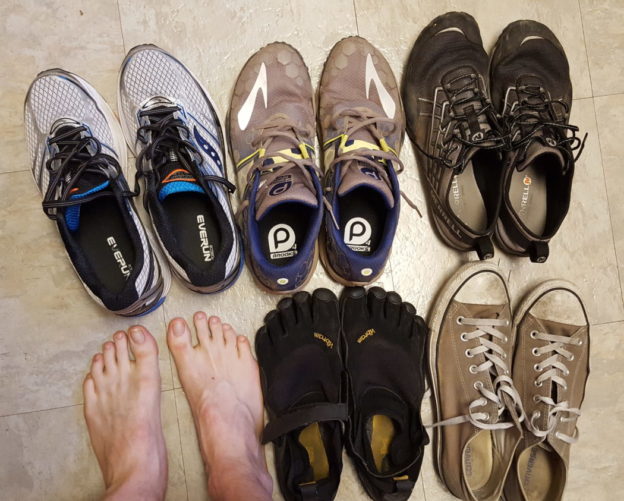A minimalist runner’s battle to overcome posterior tibial tendon dysfunction continues
My Foot Fight began in 2012 when I suffered my first running injury. I was on a six-mile pseudo barefoot run in Vibram FiveFingers, at night, on a dirt path, when my left foot slammed on a rock. It shook me up, but I pressed on – like an idiot – and finished my run.
A few weeks later I completed the Lavaman Olympic Triathlon and then finally faced the music: a stress fracture of the second metatarsal.
Since then – despite the upsetting prognosis, and later a collapsed arch and Achilles tendon issues – I’ve kept the faith in minimalist running, committed to getting back to barefoot and trudged along the slow road to recovery.
Even though I’ve made a ton of progress, I’m still dealing with foot issues from those injuries – four years later. Namely: posterior tibial tendon (PTT) dysfunction.
In the original Foot Fight article, I explained why I continue to believe barefoot running is right for me and how I planned to overcome all the setbacks as I trained for my first Ironman triathlon: Ironman Arizona 2013.
Now, after completing IMAZ2013 and shifting gears multiple times over the years (focusing less on crossing finish lines and more on surviving the MBA grind), it’s time for a long overdue update.
In this post I’ll share:
- An update to My Running Timeline,
- Foot-strengthening exercises I practiced while I wasn’t training,
- My new minimalist running recovery strategy, and
- Answers to FAQ from that original Foot Fight article, which is still getting great comments from people posting their own Foot Fight stories, PTT problems and questions about minimalist running.
I hope this gives you new ways to strengthen your feet, and inspires others dealing with PTT issues to approach minimalist running and recovery the smart way.
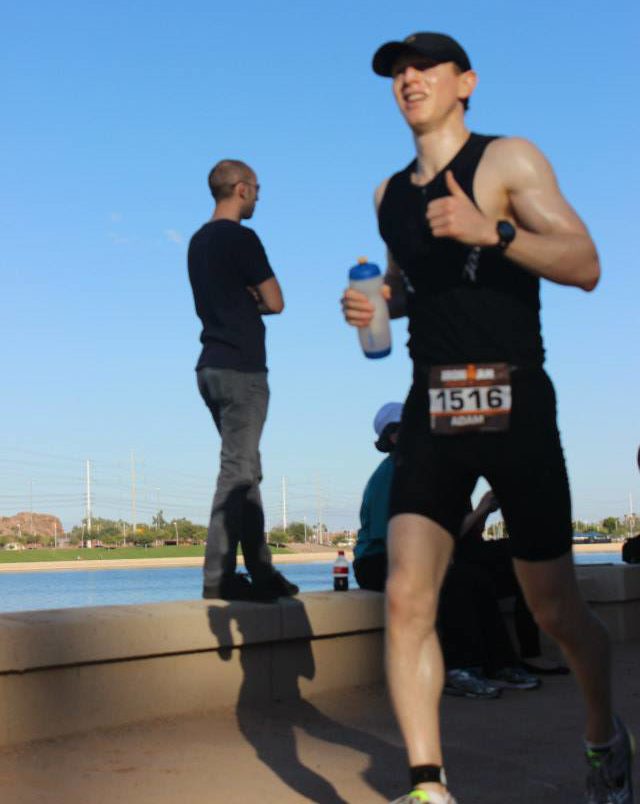
My Running Timeline (Continued from the original Foot Fight)
Age 30 (November 2013): One of the best days of my life. I overcome PTT, arch and Achilles tendon issues to dominate my first Ironman triathlon. I take it easy on the run, put the minimalist shoes away, and cross the finish line strong.
Footwear: Saucony ProGrid 8mm drop running shoes
Age 31 (February 2014): My second attempt at Ragnar Del Sol – the race that crushed my left arch back in 2013. I successfully run the same leg and distances as the prior year (about 20 miles in about 30 hours) – this time I am the one doing the crushing.
Footwear: Saucony ProGrid
Age 31 (May 2014): My first taste of trail running: about 4.5 miles in an hour with the Aravaipa Running group. Out of breath, exhausted and invigorated, I was hooked from the get go. Trail running gets you away from cars, out in nature and more engaged with your running form. The hills build strength, and the rough terrain strengthens your feet and ankles. It’s just what the doctor should have ordered.
Footwear: Brooks Pure Grit trail running shoes
Age 31 (July 2014): Ragnar Northwest Passage more than 20 miles in about 30 hours. No PTT, arch or Achilles issues. Lots of hills and good times in the PNW. On one of the legs I sprint across Deception Pass in the middle of the night. So cool.
Footwear: Saucony ProGrid
Age 31 – 33 (August 2014 – June 2016): Grad school and work take over for two years and largely slam the brakes on my fitness routine. I usually can only manage a quick light run once or twice a week. To take advantage of the lighter running load, I use this time to work my minimalist shoes back into the rotation, about every three or four runs.
Footwear: Saucony ProGrid, VFF, Brooks Pure Grit and Merrell Trail Glove 2 zero drop trail shoes
Age 33 (July 2016 – Present): Fresh off my MBA grind, I’m ready to go HAM on fitness again and continue the Foot Fight toward barefoot running. I set my sights on a 50-mile ultramarathon. I am easing myself back into a training routine that covers six days per week, and continuing to sprinkle in shorter minimalist shoe runs with longer stabilized shoe runs. As with most transitions, this one is kinda weird, and taking some time.
Footwear: Saucony ProGrid, VFF, Brooks Pure Grit and Merrell Trail Glove 2
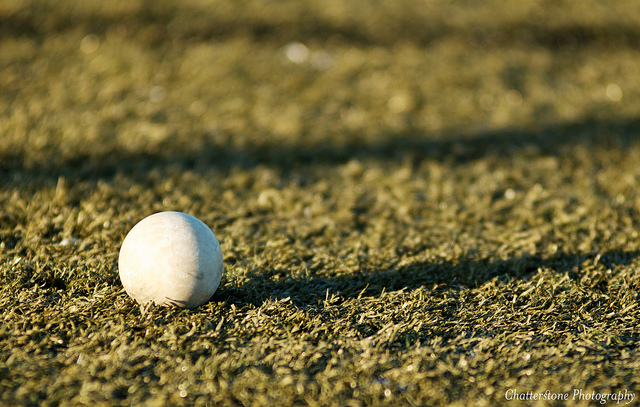
Five easy foot-strengthening exercises
Here are the quick go-to foot workouts I practiced while I was in grad school and didn’t have much time time to focus on this stuff. These exercises are cheap, simple and easy to work into morning or warm-up routines.
- Roll out the bottoms of both feet with a lacrosse ball fore one minute every day.
- Spell the alphabet in the air with each foot. If you’re like me, you will hear much cracking and crunching as you spell out each letter.
- Towel scrunches – 30 reps with each foot. You’ll feel your arches working on this one.
- Stand in front of a wall. With one foot forward a few inches away from the wall, bend your ankle forward and touch your knee to the wall without lifting your heel off the ground. Inch your foot away from the wall until you can’t touch the wall with your knee anymore. Keep practicing this to increase the max distance you’re able to be away from the wall while touching it with your knee.
- Walk around barefoot as much as possible.
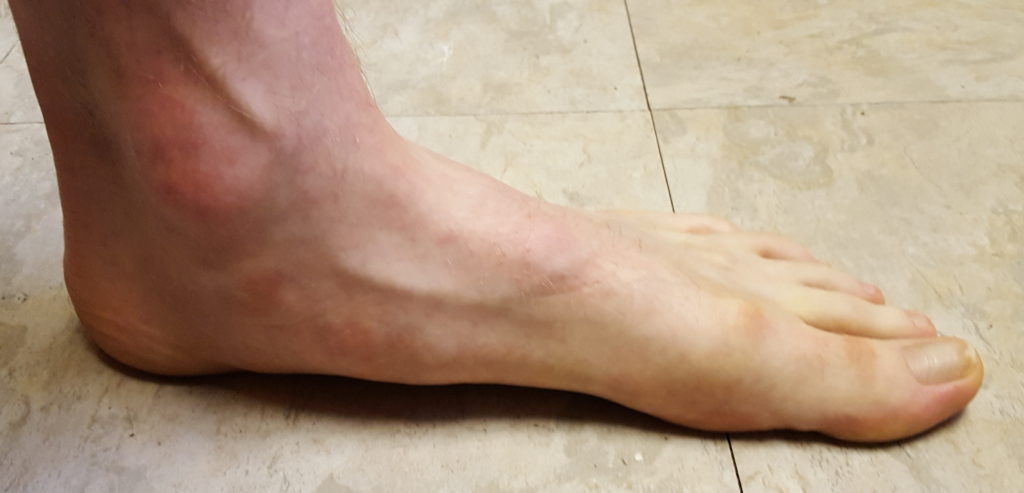
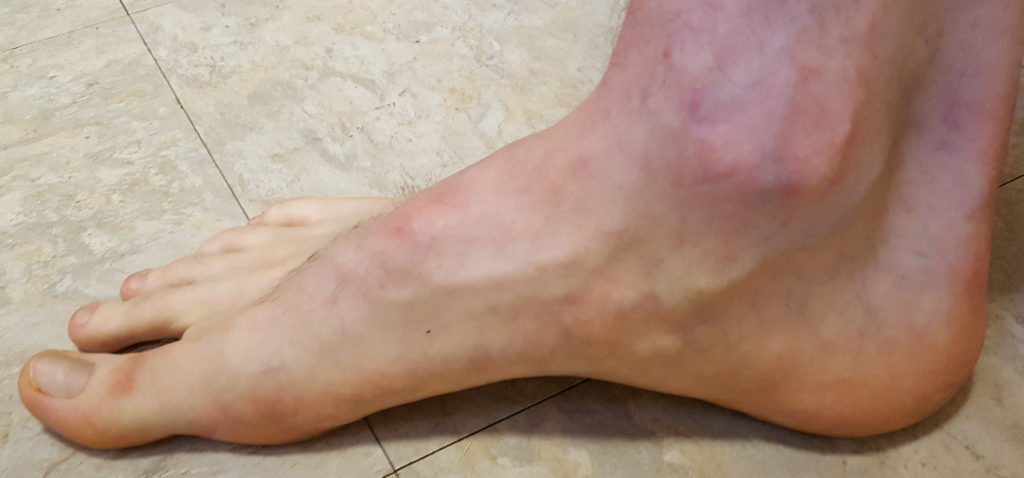
Injury status
Even though I’m running strong and no longer feeling PTT pain, I haven’t completely bounced back to my pre-arch-Recession barefoot running peak (If you can stand my nasty feet, compare the arches between my left and right feet in the photos above to compare a strong arch to one that has some room for improvement). My pampered feet enjoy the good life in stability shoes for most workouts, and all my long runs.
These days I can run about 2 – 3 miles in minimalist footwear, while maintaining good form and a decent pace. I also usually wear the minimalist shoes during strength and conditioning workouts.
Over the next few months I will look to slowly increase that distance and pace, and stay obsessive about the foot strengthening exercises listed above. Big picture, I hope to be a full-time barefoot runner in about a year or so. However, I won’t force the issue if it’s not there yet.
Mailbag – PTT FAQ
These topics (PTT and minimalist running) have driven some great conversation on this blog. For the most part, the stories and comments come from runners who are struggling with a lot of the same issues I was (and am) trying to overcome. I’ve identified a few recurring themes from the comments of the original article, and have paraphrased and summarized my general advice below if it helps others dealing with these issues. As with all of my suggestions – take them with a grain of salt because I’m not a doctor or a trained professional on these matters.
- Help! I’m in PTT pain and have a big race coming up. Should I switch to minimalist shoes to get better faster so I can still do the race? No. If you’re PTT is still weak and diseased and lame and sad and painful and doing nothing to support the emotional and physical pounding and stress your feet endure on a daily basis, then switching to minimalist shoes for a race will exacerbate the problems. Minimalist shoes are not the fast fix to PTT. Barefoot running – and fixing structural problems with flexibility and proper form – should be more of a long-term goal than a short-term solution.
- My foot doctor / physical therapist says minimalist running is crap, and that I need to buy orthotics. What do I do? Get a second or third opinion. Find a foot doctor / PT who gets it and will work with you. Most of the level-headed endurance experts I’ve spoken to about this agree orthotics are not the answer. I view orthotics as an expensive, hurried treatment of the symptom, rather than the solution to the core problem.
- I have [insert foot / PTT problem] and my feet are killing me! Any suggestions? Stop running for now. Rest, ice and find a good physical therapist who will listen and not default to orthotics. Give your feet the time and attention they need to heal.
Thanks for following along, and godspeed to everyone fighting the good Foot Fight!
As always, please feel free to post your PTT horror stories, advice on recovery, thoughts on barefoot running or experiences and opinions with any of these issues in the comments.
– Live every day –
Adam
P.S. You know this by now, but let’s make it painfully clear that I’m not a doctor or a trained medical professional. I’m just some dude, who likes to write and run. I’m happy to help, and I hope my stories and advice are useful, but you should be smart and a) consult an expert for the best way to deal with your injuries; and b) figure out what works best for you.
